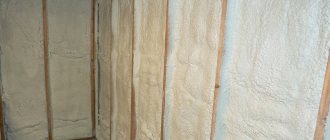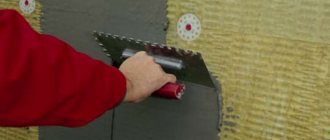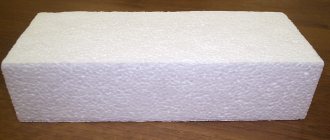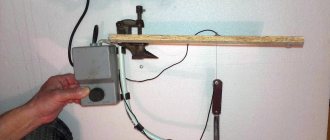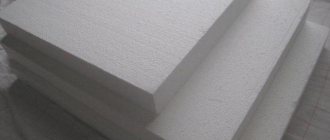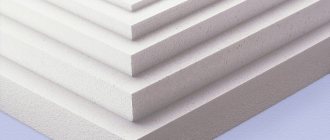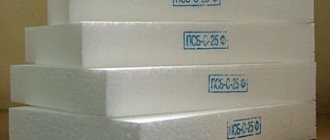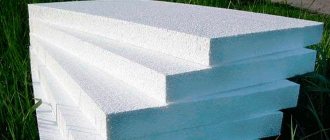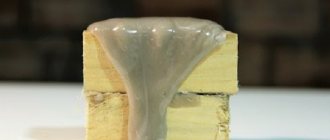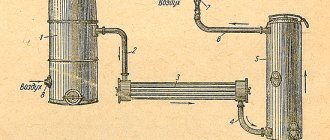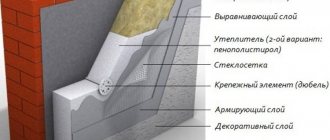Is it necessary to prime the foam before finishing work?
According to building codes and regulations, the complex of technical operations for finishing work necessarily includes the preparation of surfaces by priming. For some types of work, it is enough to wet the walls with water, but it is recommended to treat concrete, brick surfaces, as well as plaster, with a liquid primer. Priming allows you to improve the adhesion (adhesion) of the treated surface to the applied plaster or adhesive solution, as well as reduce water absorption of the porous base.
Priming polystyrene foam under plaster is one of the necessary technological operations: it increases the adhesion of mortar mixtures of finishing finishes and leveling layers. The primer, as it were, “absorbs” excess material when grouting the applied plaster. And if the primer additionally contains bactericidal components, after treating the walls it reduces the risk of fungal mold and “wetting” of the surface.
Types of primer mixtures
Primer mixtures differ in their composition, technical properties and purpose. There are universal primers with a wide range of applications, which can be used to treat surfaces with different textures and for a wide range of work.
Based on their technical properties, priming liquids are divided into means for increasing the strength of the coating and adhesion (adhesion) of the base with subsequent finishing:
- Strengthening primer mixtures are recommended for porous surface structures. The most important property of these solutions is the significant penetration depth, which is up to 100 mm. In addition, after the applied layer dries, a durable protective film is formed on the walls.
- An adhesive primer mixture is used as an intermediate layer that improves the quality of the finish. The primer is used before applying plaster and decorative types of cladding.
According to their composition, primer mixtures are alkyd, acrylic, glyphthalic, phenolic, polyvinyl acetate or perchlorovinyl.
The composition of the primer is selected depending on the performance characteristics of the plaster or tile mortar, as well as the area of application.
Primer for painting
Before painting the foam, experts advise pre-treating it with a primer liquid. The work is carried out in the following order:
- Excess objects and elements are removed from the surface of the foam.
- The slab surface is being cleaned.
- Dust and foam crumbs are removed from the surface.
- Primer is applied to the prepared surface. The number of priming layers depends on the quality of the polystyrene foam and the intended coloring.
This sequence of work completely preserves the technical properties of the foam and additionally protects it from mechanical stress.
Primer for plaster
In modern construction, plastering polystyrene foam boards has become commonplace. Indeed, in addition to the decorative and spectacular appearance of plastered multi-colored painted facades, there is additional insulation of surfaces. Priming in this process is important and the durability of textured or decorative plaster depends on this result. Textured plaster of the “bark beetle” type is applied to a primer with quartz filler. Experts recommend using Ceresit CT 16 primer – a polymer acrylic composition with quartz sand grains. And if you plan to only paint the plaster with façade paint, then it is best to use a universal primer such as Ceresit CT 17.
Primer of polystyrene foam with liquid glass
When painting expanded polystyrene, increased demands are placed on the paint composition in terms of elasticity, resistance to temperature changes and precipitation. Modern paint and varnish products meet all these requirements, but almost every composition contains aggressive components that destroy the structure of the foam. To solve this problem of deterioration, it is recommended to coat the surface of the polystyrene foam with a protective agent. For these purposes, “liquid glass” is most often used - a solution of potassium or sodium silicate. The high surface tension of the foam grains creates a reliable barrier to the penetration of liquid glass, resulting in the creation of a reliable protective film.
Attention!
To increase the elasticity of liquid glass, it is recommended to add not water, but a universal primer.
Recommendations for finishing
It is advisable to perform plastering on foam plastic immediately after the seams have dried. The longer the insulation is exposed to atmospheric influences, the lower its thermal insulation properties. Moreover, such a house cannot be left unfinished for the entire winter.
Plastering should be done in dry, warm weather and on a dry surface. The presence of moisture, dust, and greasy stains on the foam negatively affects the adhesion of the plaster to the base, as a result of which the coating very soon falls off in pieces.
When mixing the solution, strictly follow the proportions and do not add anything other than water. Factory mixtures already contain all the necessary components, and the presence of foreign impurities will only worsen the quality of the plaster. Also follow the specified application thickness - it is better to do 2 thin layers than one thick one.
Plastered surface
Decorative plaster can give a house a unique exterior
Video - Facade plaster on polystyrene foam
Video - Plastering slopes using foam plastic
Priming when insulating walls with foam plastic
Surface priming during the production of a complex of works on thermal insulation of walls is a mandatory technological operation. For these purposes, a deep penetration primer mixture is usually used. This treatment will compact the structure of the structural material and protect the walls from possible destruction. After the primer layer has dried, the polystyrene foam slabs are secured with plastic dowels with “umbrellas”, covered with a dense polyester mesh and covered with a special adhesive mixture recommended for polystyrene foam.
Before applying the plaster layer, the surface of the walls is sanded with a sanding mesh and re-treated with a primer.
The third time the primer is applied over the finished plaster before the finishing coat. The primer is selected depending on the type of final decorative coating.
Rules for applying the primer mixture
Experienced builders advise applying primer mixtures according to the following rules:
- The mixture must be mixed thoroughly. If the consistency is too thick, it is diluted with water according to the technical recommendations specified in the instructions for use.
- The primer is applied with a wide brush or an ordinary flat paint brush. You can use a paint roller or sprayer. Upon completion of work, tools must be cleaned.
- After the soil has completely dried, the surface becomes resistant to mechanical stress.
- When carrying out priming work, do not forget about personal protective equipment.
By following these simple rules, you can achieve long-term operation of the insulating coating.
Preparation of tools and materials
To perform a set of works on plastering polystyrene foam, it is necessary to prepare the appropriate tools:
- Polyurethane polishers and floats.
- Construction buckets for mixing dry plaster and adhesive mixtures.
- Construction mixer - a drill with a metal whisk.
- Painting polyester fiberglass mesh.
- Sanding mesh or sanding block.
- Stainless steel trowel.
- Set of painting spatulas with widths of 100, 200, 400 and 600 mm.
- Plaster rule from 2 to 2.5 m long with a level.
Prepare the necessary materials:
- Special glue for fixing the mesh.
- Dry plaster mixture.
- Primer.
- Material for finishing decorative coating.
Polystyrene foam is finished using special plaster mixtures, which can be divided into two groups: mineral, based on cement and sand, and acrylic.
Acrylic plaster mixture has high adhesive properties and a large selection of decorative coatings, but under the influence of ultraviolet radiation the acrylic “fading” occurs.
Leveling the base
The plaster solution is applied to a flat base. To check how evenly the polystyrene foam boards are glued, just apply a plaster rule or a wide spatula to the base. If the joints of adjacent slabs are at the same level and lie in the same plane, such a surface is considered smooth and ready for the plastering stage. Particular attention should be paid to the connecting seams between the plates - they must be carefully sealed, and excess assembly adhesive must be cut off. In order for the leveling layer to “stick” to the foam better, it is advisable to treat its surface with a needle roller and then the plaster mixture will penetrate deeply into the formed pores.
Preparation of the solution
Dry plaster mixtures intended for plastering on foam plastic are diluted with water in the proportion specified in the instructions indicated on the manufacturer's label. The construction markets offer a wide range of dry mixes from well-known brands such as Cerrazit, Henkel, Optima, Volma and other well-known companies. It is advisable to use a plaster mixture from the same manufacturer on the same wall plane. Moreover, different manufacturers offer to use two types of mixtures: one for fastening polystyrene foam boards, and the other for gluing reinforcing mesh and plaster.
The average consumption of the mixture for leveling walls is 6 kg per 1 m2.
Installation of plaster mesh
A reinforcing painting mesh made of polyester fiberglass is necessary for better fixation of the plaster mortar on the smooth surface of the foam plastic. In practice, two methods of attaching the mesh are used:
- A strip of reinforcing mesh 1 to 1.5 meters long is applied to the foam plate. The adhesive mixture is applied on top with a wide spatula and leveled over the entire surface of the reinforcing layer. The mesh is immersed in the applied solution and, as it were, completely “embedded” in the adhesive mixture.
- The adhesive solution is applied to the slab using a spatula and distributed evenly over its entire surface. Strips of painting mesh are applied to the fresh solution and smoothed over with a layer of glue.
If you compare these application methods, it is best to give preference to the second method. The main argument will be that under the reinforcing mesh there will be no empty surface without an adhesive solution and such fastening will be much stronger than in the first method of fixation.
Applying and grouting the leveling layer
The fixed reinforcing mesh must be coated with the prepared adhesive, smoothed with a plastic float and sanded with a sanding mesh. This procedure begins after the applied mixture has not completely dried. There have been cases when grouting was started the next day, after the applied solution had completely dried. It is very difficult to wipe off such a dried coating: you have to repeatedly wet the surface with water and grind the leveling layer of the solution with great effort.
The thickness of the leveling layer should not exceed 2 - 3 mm.
H2 - Primer consumption
The standard consumption of primer mixtures is important and this indicator is usually indicated by the manufacturer on the packaging label:
- Acrylic primers - standard consumption is from 80 to 120 g/m2.
- Deep penetration primers – from 50 to 150 g/m2.
- Primer with quartz filler – 150 – 200 g/m2.
Knowing this standard, you can easily calculate the amount of primer required for the work:
The quality of the complex of works on finishing foam plastic boards depends on the accuracy and sequence of all technological operations, in which the primer on foam plastic plays one of the main roles. If you violate the technology for finishing work on foam plastic, you cannot count on the durability of the finished finishing and there is a significant threat of the appearance of deformation cracks and peeling of the entire decorative coating.
What plaster should I use?
How to glue foam plastic?
It is recommended to glue polystyrene foam with cement-sand mixtures: special glue for polystyrene foam, tiles, liquid foam (Ceresit ST/84, allows you to glue foam plastic to polystyrene foam, metal, wood, glass).
Gluing polystyrene foam onto liquid foam is much more effective (best adhesion to the material), but it costs much more than conventional adhesive. When using adhesive foam, you need to have certain skills and work carefully.
The correct selection of plaster composition is also of no small importance. It is necessary to select a mixture similar in composition to facade plaster .
Most popular options
- Mineral plaster . The main composition of the mixture is cement, sand. Various mineral fillers can be added. Such plaster used to be quite in demand, today it is used less often, since more effective substitutes already exist. Its main advantage is its low cost.
- Acrylic plaster . This is a modern plaster mixture of much better quality, but its price is much higher. It is made on the basis of acrylic resins with chemical additives. This type of plaster mixture is specially designed for application to insulating materials of buildings. It fits perfectly on the smooth surface of extruded foam. Using acrylic-based plaster, you can decorate facades.
In addition to these plaster options, there are many more varieties of plaster mixtures from different manufacturers, the most popular of which are: Knauf, Ceresit, Polymer, Kreisel.
When purchasing plaster mixtures in Moscow for polystyrene foam, you should pay attention to their characteristics. It is recommended to choose fire-resistant compounds, since polystyrene foam is considered a material with an average level of flammability.
